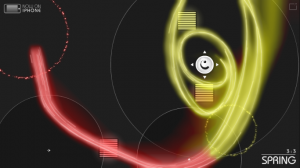222nd played so far
Genre: Puzzle/Strategy
Platform: PC
Year of Release: 2008
Developer: Cipher Prime
Slightly more tenuous as an internet link, Auditorium is available for download on Steam, iOS and other places. It started out as a flash game though, and the demo is still available as such. For the reason why this matters, you want to look at our introduction to Cursor*10.
Though the name may sound like this is a music game, it’s billed as puzzle/strategy, manipulating and generating music rather than creating it or having it involved in gameplay. It feels weird, but probably makes sense somehow.
Our Thoughts
It’s odd. Music is part of the game, but not the focus. The basic setup: As you play, you direct streams of light – perhaps representing sound, but something like that – and get it to fill a ‘counter’. As you do so, more music starts playing. Your goal is to fill all of these ‘counters’ until the full music plays.
There’s a few tools to help you do this. The most commonly used is a… thing that helps you redirect the streams. They’ll redirect the flow of light… things to go in the direction. Most of the early puzzles come down to this – changing the direction of the flow to reach the counters. You can manipulate the strength and range of this, but that’s where it goes. Another one, possibly responsible for the more beautiful looks, creates a sort-of cyclone that makes the flow rotate around it until it flies out again.
Another part of the abstract beauty the flows create is the colouring of the streams. Some counters need specific light colours to charge and play their music, and to make things so you need to direct the flow through coloured circles.
All of this is learned by doing. The game features no tutorials, but slowly builds up the difficulty of the puzzles so that with a bit of experimentation, you always know what you’ve got and where to go. That doesn’t mean it’s easy – some of the later puzzles require precise placements and some lateral thinking to come to a solution. Insight here is necessary.
As alluded to earlier, this ends up looking beautiful. The particle-based system means the stream isn’t consistent, and the trails of colours each dot leaves makes for nice streams. The music that accompanies it suits the graphics, soothing and slightly exciting. It makes for a lovely combination between the two. The thing that I especially loved is how each colour was linked to a different instrument and how the richness of the music is linked directly to how many circles you feed.
I’m not entirely sure where the strategy elements come in, but the graphics and music make for a soothing, fun experience. You won’t ever get stuck for too long or get frustrated, but as a game to wind down after a busy day, there’s little that can beat it.
Final Thoughts
This game does what Child Of Eden boasted a few years later, a true experience of synesthesia (a condition where you can hear colours and taste words). It is beautiful and well worth going beyond the original demo, as we have done.
